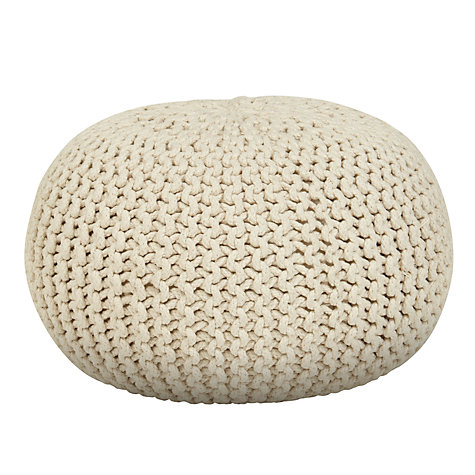Now, I would be lying if I said that this project turned out EXACTLY how I originally intended... I wanted to make something out of my crushed velvet yarn that I made last month. At first, it was going to be a knitted pouffe or ottoman, but on realising that I didn't have enough yarn, I pulled it back. (I just couldn't face cutting metres and metres of fabric again.)
Then it was going to be a floor pillow, but again, after knitting nearly all of the yarn, I realised that I didn't quite have enough for that either. So this is the pattern for my knitted round pillow... Let's call it a miniature prototype for the lovely big knitted pouffe I plan to make at some point in the future...
Many of the patterns for this kind of cushion usually involve knitting one long length of garter stitch and then gathering up the sides. I really didn't want that amount of excess fabric, so I worked mine using short rows or partial knitting.
The yarn that I made from crushed velvet fabric was really lovely to work with. It has a nice stretch to it, which made it a joy to knit with and, as it was so thick I was able to make this in just a few hours. That's my kind of project!
Having made this, I now know exactly how I'm going to be making my big pouffe... this year, maybe...
Anyway, here's the pattern that I designed.
Pattern for a small round pillow.
Mine is knitted using size 15mm circular needles I could have made it on long straight needles, but circular needles gave me the advantage of being able to fold my knitting in half to get an idea of how my knitting was progressing. You want the stitch to be quite tight so that the inner pillow doesn't show through too much.
I could have made it on long straight needles, but circular needles gave me the advantage of being able to fold my knitting in half to get an idea of how my knitting was progressing. You want the stitch to be quite tight so that the inner pillow doesn't show through too much.
The gauge of my yarn is 5.5 stitches and 8.5 rows = 10 cm square or 3wpi.
You could either make your yarn out of jersey fabric, or ply several yarns to get the desired thickness.
Row 1: k15, wrap 1 and turn.
Row 2: k12, wrap 1 and turn.
Row 3: k8, wrap 1 and turn.
Row 4: k4, wrap 1 and turn.
Row 5: k11 to the end, picking up the wraps and knitting together with the wrapped stitches. (For reference, the wrapped stitches are stitches 5 and 9.)
Row 6: k18, to the end, picking up the wraps and knitting together with the wrapped stitches. (For reference, the wrapped stitches are stitches 12 and 16.)
Repeat these 6 rows until your knitting will loop around to form a circle when it's lightly stretched.
For guidance, my cushion used 18 pattern repeats or 108 rows.
Using the long cast on tail, gather up 1 of the side seams to loop the cushion around into a circle.
Crochet the cast on and cast off seams together to about 3/4 of the way down.
Use a crochet hook to further close the first gathered centre if required.
Turn the cushion to the right side. Insert your cushion pad or stuffing.
Continue sewing the seam together, with a crochet hook. Finish by gathering up the second side seam, closing the hole as much as possible.
Some of my other knitting blog posts
 |
| Virtually No-Sew Knitted Hearts |
 |
| Giant Rainbow Pillow Knitting Pattern |
 |
| Bohemian Wreath Knitting Instructions |
 |
| Craftmehappy Joyful Loop Stitch Wreath Base |
 |
| How to Knit Curlicues or Spirals |
----------
Please be sweet and share the love. Leave a comment, subscribe to my YouTube channel, like my Facebook page for regular updates or follow me on Pinterest, Bloglovin' or Instagram





























